Distaste vs. Disgust Disgust stems from a more basic emotion – distaste – which is shared among man and animals alike. Rats display a distaste expression similar to babies – wrinkled nose, downturned mouth, tongue pushed out. But in humans, 'distaste' evolves into its more complex cousin 'disgust'. Around age four to eight, non-food items – think body products and roadkill – begin to elicit disgust responses. Even later, society adds new things to your personal chorus of disgust triggers – perhaps sex, perhaps caste system violations, perhaps blasphemy. No matter the specifics, the expression of disgust is universal across all cultures, and very similar to that expression of distaste we share with animals. What things are universally disgusting? Researchers Paul Rozin and April Fallon have proposed a three-criteria test for "core disgust" – i.e. those things that would be considered disgusting by all people. The criteria are: 1. something you could eat Even as we're preoccupied with such imaginary scenarios, we shovel real filth into our mouths. Take a look at the FDA's Food Defect Action Levels, also known as minimum filth guidelines. They set forth the acceptable levels of things like rodent hairs, insect parts, mites, and animal excrement in everyday foods like spices, noodles, flour, and peanut butter. Given our tacit acceptance of real filth and our decisive rejection of imaginary filth, the mind clearly plays a powerful role in disgust. What is it trying to protect us from? Why do we get so worked up by disgust? Disgust reminds of our unpleasant animal origins, and the displeasure we feel reinforces our sense of civility and humanity. Put another way, disgust represents our rejection of our animalistic nature. Rozin sums it up well, "It's hard to imagine civilization and culture without disgust, the sense of what's inappropriate. If you could imagine a person who is free of disgust, it's sort of hard to imagine how they would be distinctly human. It's got to do with the modern sensibility; it is the sign of civilization." So disgust is a badge of honor, belonging only to homo sapiens and uniting us in our humanity. The triggers may be different across cultures, but that strong sense of disgust is always there, somewhere. Let's all embrace this unity. Take your neighbor's hand in celebration of our oneness -- just make sure to wash yours afterward. Take a Quiz: Where Are You on the Disgust Scale? This is Jonathan Haidt, Clark McCauley and Paul Rozin's official study. Registration required to see results. More Reading: Photo Sources: We people eat some very disgusting things.
We people eat some very disgusting things.
Fish heads in Scotland, ox penises in China, pig intestines the American south, spiders in Cambodia, field rats in North Korea, cow kidneys in England, hog brains in the Ohio River Valley, cow tongue in Mexico, and even duck fetuses in the Philippines.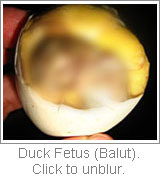 You may think these exotic foods are far removed from your own neat, civilized existence. But you yourself eat a goopy liquid that oozes from the body of an insect -- honey. You also eat rodent hair, insect parts, beetle eggs, and mites every day (keep reading).
You may think these exotic foods are far removed from your own neat, civilized existence. But you yourself eat a goopy liquid that oozes from the body of an insect -- honey. You also eat rodent hair, insect parts, beetle eggs, and mites every day (keep reading).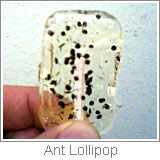 Does this gross you out? Why? After all, excluding vegetarians, everyone on Earth eats dead animals and their parts. Certain things gross us out, while seemingly similar things don't. Even imaginary notions can turn our stomachs. It turns out that the sense of disgust is not as simple as it would appear.
Does this gross you out? Why? After all, excluding vegetarians, everyone on Earth eats dead animals and their parts. Certain things gross us out, while seemingly similar things don't. Even imaginary notions can turn our stomachs. It turns out that the sense of disgust is not as simple as it would appear.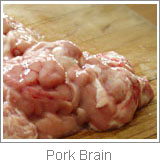 Scientists know two things for sure: disgust is one of the most powerful and primal emotions, and disgust is limited to humans.
Scientists know two things for sure: disgust is one of the most powerful and primal emotions, and disgust is limited to humans.
2. something that has or had a life of its own
3. something that has the power to make other things disgusting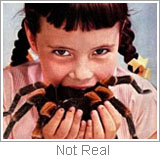 This last item is interesting – it causes the resistance by some people to sleep in a room where someone had died the night before, for example. For many, a dead body has the power to contaminate an environment. Consider a glass that had just been thoroughly sterilized and cleaned of
This last item is interesting – it causes the resistance by some people to sleep in a room where someone had died the night before, for example. For many, a dead body has the power to contaminate an environment. Consider a glass that had just been thoroughly sterilized and cleaned of 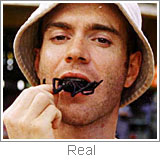 pungent, maggot-infested rat droppings. If given the choice, would you skip over that glass and grab another? Would you be able to drink perfectly pure water recycled from urine, as astronauts do? Imagined contamination packs a powerful punch of disgust.
pungent, maggot-infested rat droppings. If given the choice, would you skip over that glass and grab another? Would you be able to drink perfectly pure water recycled from urine, as astronauts do? Imagined contamination packs a powerful punch of disgust.
The Anatomy of Disgust by William Miller
Body, Psyche, and Culture: The Relationship Between Disgust and Morality by Haidt, Rozin, McCauley, and Imada.
Ant Lollipop: from Wikimedia
Girl Eating Spider: from melissarocks666's collection at photobucket.com
Balut (Duck Embryo): from Wikimedia
Man Eating Spider: from Rhymer Rigby's Spider-Eating Travel Diary
The Face of Disgust: from cheezeaddict's Flickr stream.
Disgust - Can't Live Without It
Craig Cochrane
Reviewed by QualityHealth's Medical Advisory Board
Updated: November 24, 2008
Related Health Centers
THE BASICS
SPECIAL DIETS
RELATED HEALTH CENTERS
Explore Original Articles About...
Quick Links:
Health Centers:
ADD/ADHD
Allergies
Alzheimer's Disease
Anxiety
Arthritis
Asthma
Autism
Bipolar Disorder
Breast Cancer
Cancer
Caregiving
Children's
Cholesterol
Colds & Infections
COPD
Crohn's Disease
Dental & Vision
Depression
Diabetes
Diet & Weight Loss
Eating & Nutrition
Epilepsy
Erectile Dysfunction
Fitness & Exercise
Flu Treatment
Healthy Aging & Retirement
Heart Health
Heartburn & GERD
IBS
Incontinence
Men's Health
Meningitis
Menopause
Mental Health & Addiction
Migraines & Headaches
Multiple Sclerosis
Osteoporosis
Pain Management
Parkinson's Disease
Pregnancy
Relationships & Emotional Health
Sexual Health
Skin Care & Beauty
Sleep Management
Smoking Cessation
Stomach & Digestive
Women's Health
|
|  |
|




